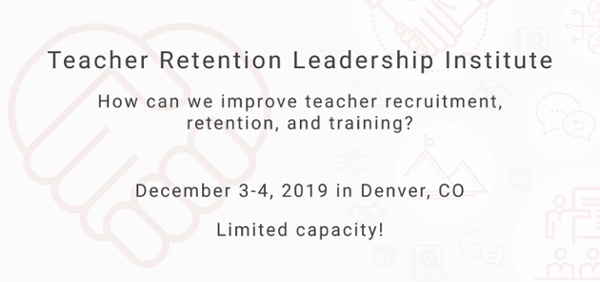
Attract and Retain Teachers with Effective Methods Using Data to Define Needs
School Districts | Innovative Leadership | Teacher Retention
Teaching, often considered one of the most noble professions one can pursue, has been a consistent driver of the innovation and ideas that progress society forward. Great leaders, creators, and thinkers have been fostered in some way by a teacher who engaged, mentored, and motivated them to achieve their goals. Yet though the demand for talented, caring educators has never been higher, the pool of applicants continues to dwindle. Teachers are leaving the profession in record numbers with complaints of burnout, and young people are deciding to pursue careers in fields that are perceived to be more lucrative and stable.
Around the country, districts are experiencing shortages in wide variances; with some in need of qualified applicants for specific subject areas, and others simply hoping to have a teacher for every classroom by the first day of school. Additionally, districts with a relatively stable staffing situation may be faced with an uncertain future, as the values of our current workforce continue to change. Teacher recruitment and retention is an issue top of mind for districts everywhere. When proposing a solution to this complex issue, districts have typically been focused on broadening their recruiting pipelines, or have been relegated to relying on local and national teacher preparation programs to surface potential candidates. These strategies and partnerships fall short, however, as their focus on recruitment does not adequately address teacher turnover – and the Economic Policy Institute finds that teacher shortages result primarily from high rates of turnover, rather than an insufficient supply. Therefore, even the most effective recruiting strategies will only continue to perpetuate the cycle of alienating potential educators from the profession if they don’t come coupled with a strong hiring and onboarding process, consistent means of support, and a plan to empower your hires to grow professionally.
Sustainable solutions are derived when districts invest sufficient time and resources into better understanding their unique context and needs, as well as employing targeted strategies to identify the talent and candidate pipelines to meet them. Districts must have systems in place to identify specific areas of need, surface the root cause of the need, and determine how to leverage current strengths while planning for strategic organizational pivots when necessary. Utilizing a range of data sources, from surveying current teachers and learning what they enjoy about their work and the challenges they face, to analyzing trends of the local labor market, will allow your district to narrow its focus and more efficiently dedicate resources to the proper channels. Education Commission of the States finds that most districts’ need for recruiting and retaining the right teachers in the right subjects for the right schools typically develops from one of three sources: a lack of candidate diversity, a shortage at specific positions, or a combination of factors leading to more intensive needs. Focusing on these unique needs can lead to the development of more targeted goals and recruitment processes.
Research and data collection provide a strong foundation for addressing any teacher retention concerns, and lead to the development of effective local practices to attract quality candidates who will be presented with a supportive environment with a higher likelihood of retention. The following processes have proven to be effective district-level strategies to attract candidates.
Related Resource: If you're looking for more ways to grow leadership at your organization - from administration at the district level to teachers in classrooms - and develop innovative thinking around addressing challenges like this teacher retention check out our Ultimate Guide to Leadership Development.
1. Engage in a Community-Aligned Rebrand
Denver Public Schools and the city of Denver partnered to create the Make Your Mark campaign, a national recruitment effort based on the research-backed theory that diverse teachers can better serve diverse students. The goal of the program was to start closing the achievement gap by addressing a district-wide diversity-hiring gap. Three-quarters of DPS’s students are students of color, while fewer than half of those populations are demonstrating proficiency. Only 25% of the district’s teachers are educators of color, with many of them reporting feelings of isolation in their roles and a lack of value for their contributions. With this understanding solidly in place, DPS made it their focus to diminish those gaps and attract diverse candidates. Behind the Make Your Mark brand, the district launched a new website and social media campaign, convened a group of community leaders, educators of color, and school administrators, and strategically identified educator preparation programs and career fairs in states with a more diverse applicant pool. The team set a goal to attract more than 70 exceptional teachers of color and 10 school leaders of color, and referenced data reports regularly to review their progress, track candidates, and iterate on strategies.
2. Shift Language in Job Descriptions
Districts struggling to attract teachers could also consider making changes to job descriptions to allow for more flexible thinking around what those positions entail or how teachers could be shared across classrooms and schools. A report from the Learning Policy Institute offers several examples of non-traditional approaches towards school staffing that could increase the opportunities students have to access high quality instruction. Districts facing these concerns across 40 states have taken measures such as:
- Implementing structures where a lead teacher supports less experienced teachers across multiple classrooms
- Coupling teacher-led instruction with online learning time where dedicated paraprofessionals and substitutes monitor student learning
- Utilizing video-conferencing tools to allow teachers to lead lessons and support students remotely
Related Resource: Read more about the 8 Design Elements of Teacher Retention and our strategies for improving teacher recruitment, support, and happiness.
3. Develop Innovative and Sustained Pipelines Internally
To reduce barriers of entry for potential candidates, districts may need to deploy more intensive strategies. Through “Grow Your Own” initiatives in states like Illinois and Missouri, districts have found a way to attract teachers from previously untapped sources within their local communities. These plans aim to develop quality teacher-career pathways through local partnerships and community-based programs, as well as providing incentives like college loan forgiveness for aspiring and current teachers seeking to serve in or earn certification in areas of high need. Around the country, districts in urban settings have begun implementing these programs and found them to be effective measures in addressing gaps in the workforce.
The complex challenge of attracting and retaining quality educators isn’t showing any signs of going away, and it is critical to put the resources in place to better understand the nature of the issue. Only when we gain a true understanding of the contributing factors can we effectively design interventions to retain quality instructors, while identifying new methods of attracting potential candidates. High quality educators impact the young people who cross their paths, the classrooms they teach directly, and the schools and greater communities they serve. Districts around the country are taking steps in the right direction to truly elevate this profession and recognize the importance of the teachers who mold our future and foster a sense of purpose within our students.
Join us as we dive into the topic of teacher retention at our upcoming institute. The Teacher Retention Leadership Institute is a targeted, two-day workshop developed just for innovative education leaders working hard to address challenges and improve learning outcomes.
About Justin Toomer
Justin Toomer is a Senior Design Principal at Education Elements, working with the Design & Implementation team to help districts and their schools around the country improve their student growth and success. A first-generation college graduate, he began his teaching career in Colorado with an intention to increase the opportunities for all students to access a quality and equitable academic experience. He has experienced success working in independent, public, and charter schools; and has taught at the elementary, middle, and high school level. After teaching, Justin took an administrative position as Dean of Students at the Denver School of Science and Technology, where he set and led the school’s vision for its culture, support, and accountability systems. He has provided Personalized Learning consulting services with the Kenai Peninsula Borough School District, Kansas State Department of Education, Corcoran Unified School District, and Fresno Unified School District.



